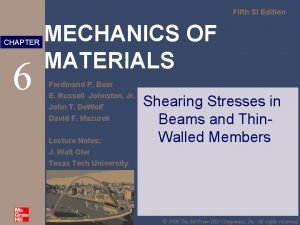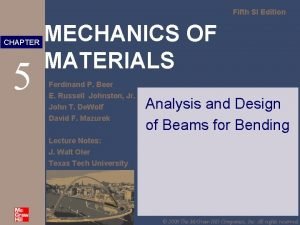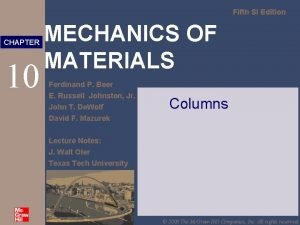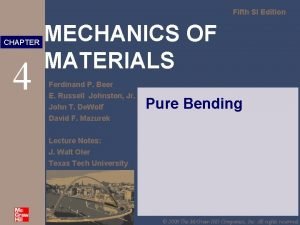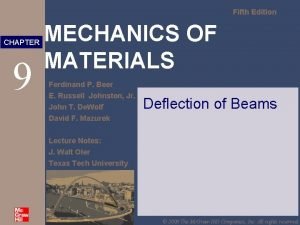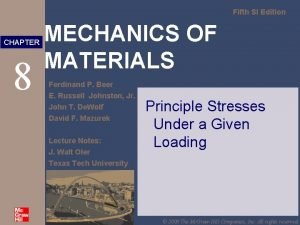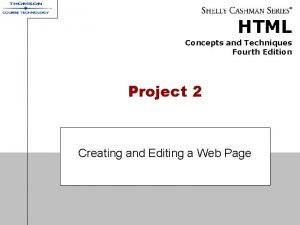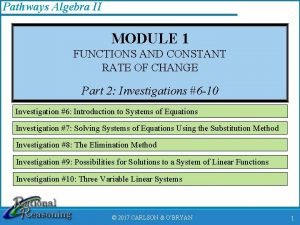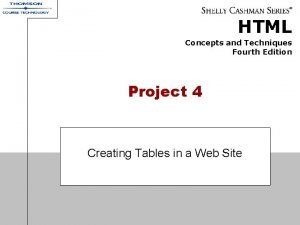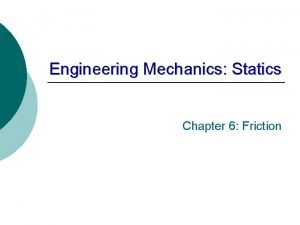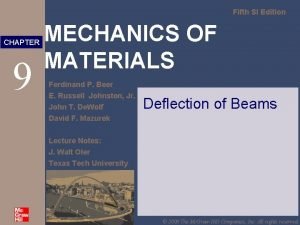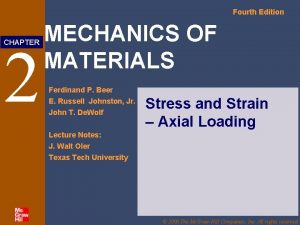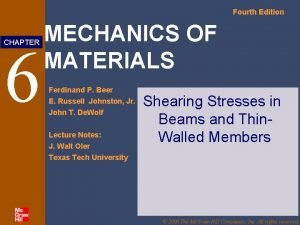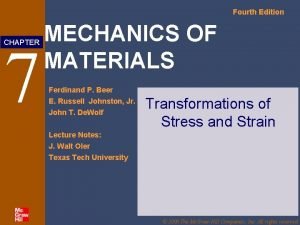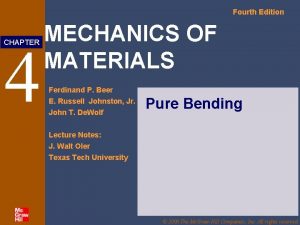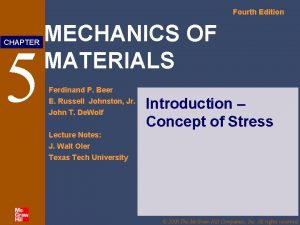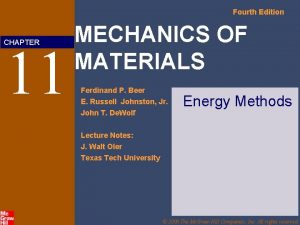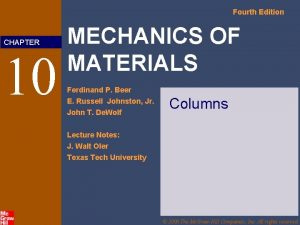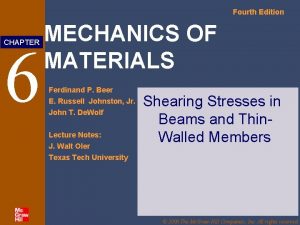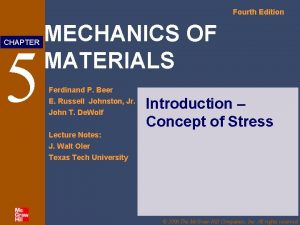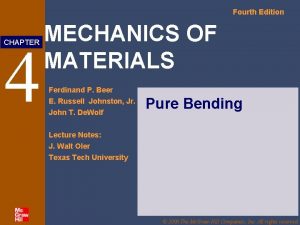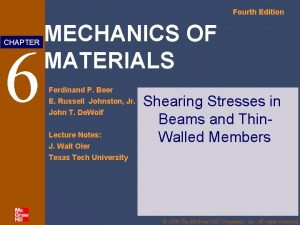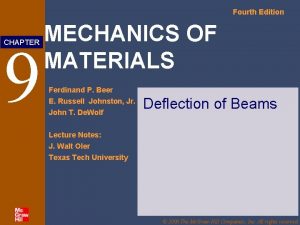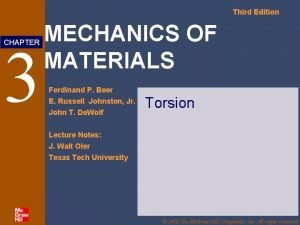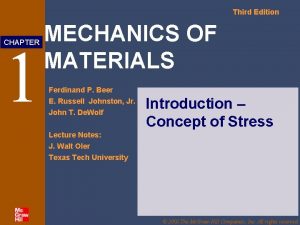Fourth Edition 3 CHAPTER MECHANICS OF MATERIALS Ferdinand

















- Slides: 17

Fourth Edition 3 CHAPTER MECHANICS OF MATERIALS Ferdinand P. Beer E. Russell Johnston, Jr. John T. De. Wolf Torsion Lecture Notes: J. Walt Oler Texas Tech University © 2006 The Mc. Graw-Hill Companies, Inc. All rights reserved.

Fourth Edition MECHANICS OF MATERIALS Beer • Johnston • De. Wolf Contents Introduction Statically Indeterminate Shafts Torsional Loads on Circular Shafts Sample Problem 3. 4 Net Torque Due to Internal Stresses Design of Transmission Shafts Axial Shear Components Stress Concentrations Shaft Deformations Plastic Deformations Shearing Strain Elastoplastic Materials Stresses in Elastic Range Residual Stresses Normal Stresses Example 3. 08/3. 09 Torsional Failure Modes Torsion of Noncircular Members Sample Problem 3. 1 Thin-Walled Hollow Shafts Angle of Twist in Elastic Range Example 3. 10 © 2006 The Mc. Graw-Hill Companies, Inc. All rights reserved. 2

Fourth Edition MECHANICS OF MATERIALS Beer • Johnston • De. Wolf Torsional Loads on Circular Shafts • Interested in stresses and strains of circular shafts subjected to twisting couples or torques • Turbine exerts torque T on the shaft • Shaft transmits the torque to the generator • Generator creates an equal and opposite torque T’ © 2006 The Mc. Graw-Hill Companies, Inc. All rights reserved. 3

Fourth Edition MECHANICS OF MATERIALS Beer • Johnston • De. Wolf Net Torque Due to Internal Stresses • Net of the internal shearing stresses is an internal torque, equal and opposite to the applied torque, • Although the net torque due to the shearing stresses is known, the distribution of the stresses is not. • Distribution of shearing stresses is statically indeterminate – must consider shaft deformations. • Unlike the normal stress due to axial loads, the distribution of shearing stresses due to torsional loads can not be assumed uniform. © 2006 The Mc. Graw-Hill Companies, Inc. All rights reserved. 4

Fourth Edition MECHANICS OF MATERIALS Beer • Johnston • De. Wolf Axial Shear Components • Torque applied to shaft produces shearing stresses on the faces perpendicular to the axis. • Conditions of equilibrium require the existence of equal stresses on the faces of the two planes containing the axis of the shaft. • The existence of the axial shear components is demonstrated by considering a shaft made up of axial slats. • The slats slide with respect to each other when equal and opposite torques are applied to the ends of the shaft. © 2006 The Mc. Graw-Hill Companies, Inc. All rights reserved. 5

Fourth Edition MECHANICS OF MATERIALS Beer • Johnston • De. Wolf Shaft Deformations • From observation, the angle of twist of the shaft is proportional to the applied torque and to the shaft length. • When subjected to torsion, every cross-section of a circular shaft remains plane and undistorted. • Cross-sections for hollow and solid circular shafts remain plain and undistorted because a circular shaft is axisymmetric. • Cross-sections of noncircular (nonaxisymmetric) shafts are distorted when subjected to torsion. © 2006 The Mc. Graw-Hill Companies, Inc. All rights reserved. 6

Fourth Edition MECHANICS OF MATERIALS Beer • Johnston • De. Wolf Shearing Strain • Consider an interior section of the shaft. As a torsional load is applied, an element on the interior cylinder deforms into a rhombus. • Since the ends of the element remain planar, the shear strain is equal to angle of twist. • It follows that • Shear strain is proportional to twist and radius © 2006 The Mc. Graw-Hill Companies, Inc. All rights reserved. 7

Fourth Edition MECHANICS OF MATERIALS Beer • Johnston • De. Wolf Stresses in Elastic Range • Multiplying the previous equation by the shear modulus, From Hooke’s Law, , so The shearing stress varies linearly with the radial position in the section. • Recall that the sum of the moments from the internal stress distribution is equal to the torque on the shaft at the section, • The results are known as the elastic torsion formulas, © 2006 The Mc. Graw-Hill Companies, Inc. All rights reserved. 8

Fourth Edition MECHANICS OF MATERIALS Beer • Johnston • De. Wolf Normal Stresses • Elements with faces parallel and perpendicular to the shaft axis are subjected to shear stresses only. Normal stresses, shearing stresses or a combination of both may be found for other orientations. • Consider an element at 45 o to the shaft axis, • Element a is in pure shear. • Element c is subjected to a tensile stress on two faces and compressive stress on the other two. • Note that all stresses for elements a and c have the same magnitude © 2006 The Mc. Graw-Hill Companies, Inc. All rights reserved. 9

Fourth Edition MECHANICS OF MATERIALS Beer • Johnston • De. Wolf Torsional Failure Modes • Ductile materials generally fail in shear. Brittle materials are weaker in tension than shear. • When subjected to torsion, a ductile specimen breaks along a plane of maximum shear, i. e. , a plane perpendicular to the shaft axis. • When subjected to torsion, a brittle specimen breaks along planes perpendicular to the direction in which tension is a maximum, i. e. , along surfaces at 45 o to the shaft axis. © 2006 The Mc. Graw-Hill Companies, Inc. All rights reserved. 10

Fourth Edition MECHANICS OF MATERIALS Beer • Johnston • De. Wolf Sample Problem 3. 1 SOLUTION: • Cut sections through shafts AB and BC and perform static equilibrium analyses to find torque loadings. • Apply elastic torsion formulas to find minimum and maximum stress on shaft BC. Shaft BC is hollow with inner and outer • Given allowable shearing stress diameters of 90 mm and 120 mm, and applied torque, invert the respectively. Shafts AB and CD are solid elastic torsion formula to find the of diameter d. For the loading shown, required diameter. determine (a) the minimum and maximum shearing stress in shaft BC, (b) the required diameter d of shafts AB and CD if the allowable shearing stress in these shafts is 65 MPa. © 2006 The Mc. Graw-Hill Companies, Inc. All rights reserved. 11

Fourth Edition MECHANICS OF MATERIALS Beer • Johnston • De. Wolf Sample Problem 3. 1 SOLUTION: • Cut sections through shafts AB and BC and perform static equilibrium analysis to find torque loadings. © 2006 The Mc. Graw-Hill Companies, Inc. All rights reserved. 12

Fourth Edition MECHANICS OF MATERIALS Beer • Johnston • De. Wolf Sample Problem 3. 1 • Apply elastic torsion formulas to find minimum and maximum stress on shaft BC. • Given allowable shearing stress and applied torque, invert the elastic torsion formula to find the required diameter. © 2006 The Mc. Graw-Hill Companies, Inc. All rights reserved. 13

Fourth Edition MECHANICS OF MATERIALS Beer • Johnston • De. Wolf Angle of Twist in Elastic Range • Recall that the angle of twist and maximum shearing strain are related, • In the elastic range, the shearing strain and shear are related by Hooke’s Law, • Equating the expressions for shearing strain and solving for the angle of twist, • If the torsional loading or shaft cross-section changes along the length, the angle of rotation is found as the sum of segment rotations © 2006 The Mc. Graw-Hill Companies, Inc. All rights reserved. 14

Fourth Edition MECHANICS OF MATERIALS Beer • Johnston • De. Wolf Statically Indeterminate Shafts • Given the shaft dimensions and the applied torque, we would like to find the torque reactions at A and B. • From a free-body analysis of the shaft, which is not sufficient to find the end torques. The problem is statically indeterminate. • Divide the shaft into two components which must have compatible deformations, • Substitute into the original equilibrium equation, © 2006 The Mc. Graw-Hill Companies, Inc. All rights reserved. 15

Fourth Edition MECHANICS OF MATERIALS Beer • Johnston • De. Wolf Sample Problem 3. 4 SOLUTION: • Apply a static equilibrium analysis on the two shafts to find a relationship between TCD and T 0. • Apply a kinematic analysis to relate the angular rotations of the gears. • Find the maximum allowable torque on each shaft – choose the smallest. Two solid steel shafts are connected by gears. Knowing that for each shaft • Find the corresponding angle of twist G = 11. 2 x 106 psi and that the for each shaft and the net angular allowable shearing stress is 8 ksi, rotation of end A. determine (a) the largest torque T 0 that may be applied to the end of shaft AB, (b) the corresponding angle through which end A of shaft AB rotates. © 2006 The Mc. Graw-Hill Companies, Inc. All rights reserved. 16

Fourth Edition MECHANICS OF MATERIALS Beer • Johnston • De. Wolf Sample Problem 3. 4 SOLUTION: • Apply a static equilibrium analysis on the two shafts to find a relationship between TCD and T 0. © 2006 The Mc. Graw-Hill Companies, Inc. All rights reserved. • Apply a kinematic analysis to relate the angular rotations of the gears. 17
 Mechanics of materials 6th edition solutions chapter 10
Mechanics of materials 6th edition solutions chapter 10 Mechnaines of material chapter 7 answer
Mechnaines of material chapter 7 answer Beer johnston
Beer johnston Chapter 5 mechanics of materials solutions
Chapter 5 mechanics of materials solutions Mechanic of materials
Mechanic of materials Mechanics of materials chapter 4
Mechanics of materials chapter 4 Mechanics of materials 6th edition solutions chapter 9
Mechanics of materials 6th edition solutions chapter 9 Beer johnston
Beer johnston Project 2 fourth edition
Project 2 fourth edition Pathways algebra 2
Pathways algebra 2 Ethics in information technology fourth edition
Ethics in information technology fourth edition Ethics in information technology 6th edition answers
Ethics in information technology 6th edition answers Html code for creating web page
Html code for creating web page Discrete math susanna epp
Discrete math susanna epp Expert systems: principles and programming, fourth edition
Expert systems: principles and programming, fourth edition Friction chapter in engineering mechanics
Friction chapter in engineering mechanics Statics
Statics Mechanics of materials chapter 9
Mechanics of materials chapter 9


